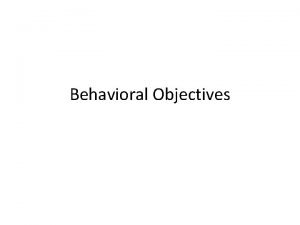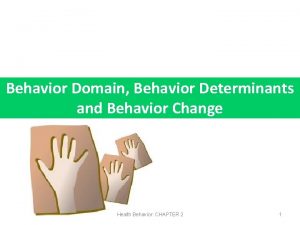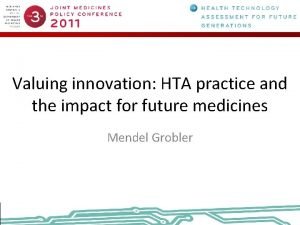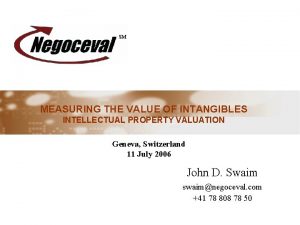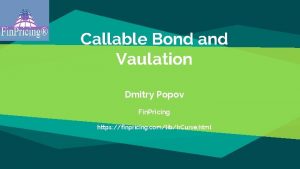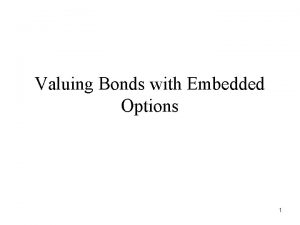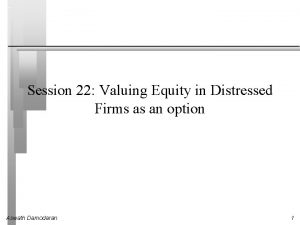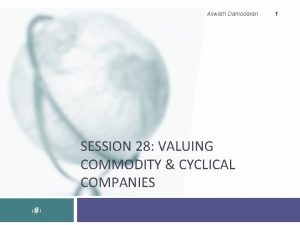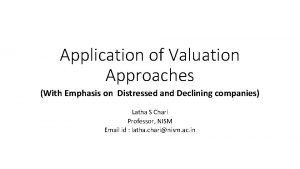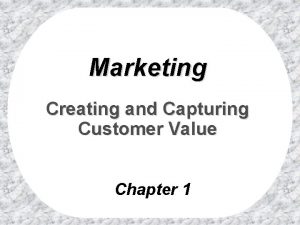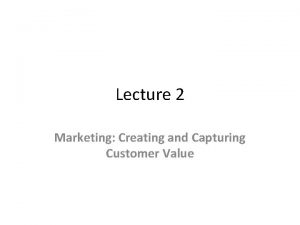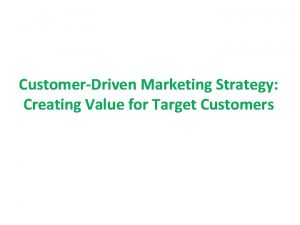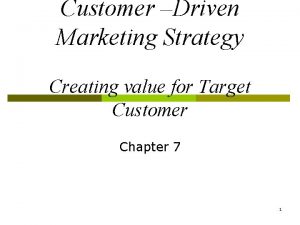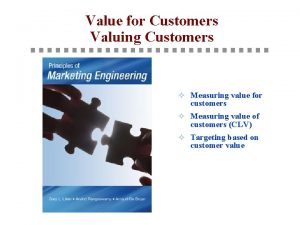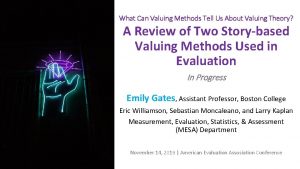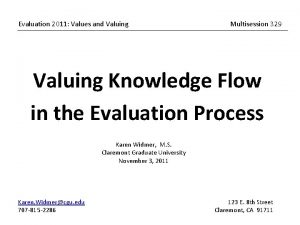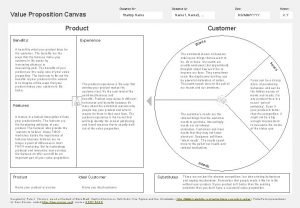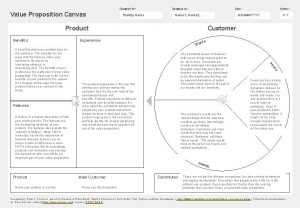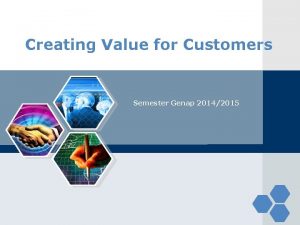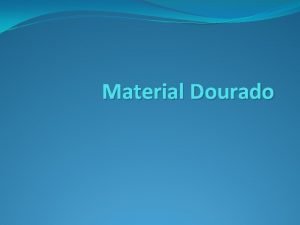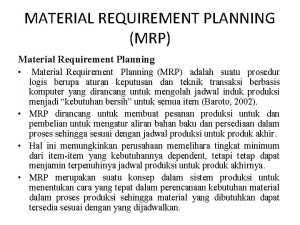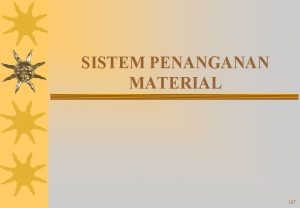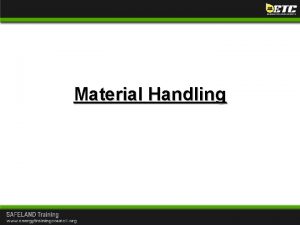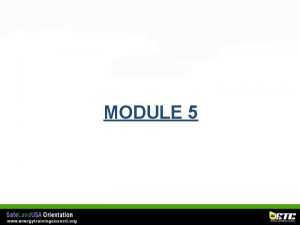Value for Customers Valuing Customers Material designed to









































































- Slides: 73

Value for Customers & Valuing Customers Material designed to accompany the book Principles of Marketing Engineering and Analytics by Lilien, Rangaswamy and De Bruyn, and the marketing analytics software Enginius available at http: //www. enginius. biz 1. 2. Measuring value for customers 3. Targeting based on customer value Measuring value of customers (CLV) © Copyright Decision. Pro, Inc. 2018. Commercial distribution and any publication is not authorized. Copying and distribution for noncommercial educational purposes only is authorized if this notice appears © Copyright Decision. Pro, Inc. 2018. Commercial distribution and any publication is not authorized. Copying and on every copy. distribution for non-commercial educational purposes only is authorized if this notice appears on every copy. 1

Quotes for the Day Anyone can measure the number of seeds in an apple. Who can measure the number of apples in a seed? --Anon Price is an observable description of a state of the market. Customer value is the hidden source of ideas about what to do to make a market more profitable for the business. © Copyright Decision. Pro, Inc. 2018. Commercial distribution and any publication is not authorized. Copying and distribution for non-commercial educational purposes only is authorized if this notice appears on every copy. 2

Customer Needs and Customer Value Measurement Customer Needs and Buying Process Behaviors Ignore Present State Postpone Functional and Economic Needs Perceived and Psychological Needs Desired State Engage in Purchase Process • Search for options • Evaluate options • Choose option • Purchase Option • Use Option Motivation Customer Value Measurement Approaches Objective Measures of Value Perceptual Measures of Value Behavioral Measures of Value © Copyright Decision. Pro, Inc. 2018. Commercial distribution and any publication is not authorized. Copying and distribution for non-commercial educational purposes only is authorized if this notice appears on every copy. 3

Definition of Objective Customer Value The hypothetical price for a supplier’s offering at which a particular customer would be at overall economic breakeven relative to the best alternative available to that customer for performing a set of functions. This approach to measuring customer value is typically useful in B 2 B situations. © Copyright Decision. Pro, Inc. 2018. Commercial distribution and any publication is not authorized. Copying and distribution for non-commercial educational purposes only is authorized if this notice appears on every copy. 4

Cost, Price, and Customer Value Potential Value Lost Perceived Value Distributed or Economic Driving Force Price Value Created Margin Value Added Total Cost of Goods and Services © Copyright Decision. Pro, Inc. 2018. Commercial distribution and any publication is not authorized. Copying and distribution for non-commercial educational purposes only is authorized if this notice appears on every copy. 5

An Example… Steel Manufacturer develops new “Rapid. Form” steel for a muffler application: • Reduces Scrap • Runs Faster …Than the “Incumbent” – High Carbon Steel. What is the value-in-use of Rapid. Form in this application for this customer? © Copyright Decision. Pro, Inc. 2018. Commercial distribution and any publication is not authorized. Copying and distribution for non-commercial educational purposes only is authorized if this notice appears on every copy. 6

VIU Example: “Rapid. Form” Steel vs. High Carbon (HC) Steel in stamped automotive part… · Long Coil Etc. . . HC Steel “Riverside” plant “Partsco” Application - 2 lbs/part @ 60¢ lb. - 25% scrap rate - 80¢ Machine time Rapid Form - 2 lbs @ ? ? ¢ lb - 5% scrap rate - 70¢ Machine time © Copyright Decision. Pro, Inc. 2018. Commercial distribution and any publication is not authorized. Copying and distribution for non-commercial educational purposes only is authorized if this notice appears on every copy. 7

Original Rapid. Form Pricing • • • It cost very little more to make Rapid. Form And H-C sells for $0. 60/lb Let’s try $0. 70/lb They’ll buy at $0. 68/lb We’ll make a bundle… © Copyright Decision. Pro, Inc. 2018. Commercial distribution and any publication is not authorized. Copying and distribution for non-commercial educational purposes only is authorized if this notice appears on every copy. 8

Example Calculations “The hypothetical price of an offering for a particular customer in a particular application, that leaves the customer at overall economic breakeven with respect to the next best alternative…” RF: HC: (2 x. 60) +. 80 (1 -. 25) = (2 x VRF) +. 70 (1 -. 05) . 92¢/lb = VRF © Copyright Decision. Pro, Inc. 2018. Commercial distribution and any publication is not authorized. Copying and distribution for non-commercial educational purposes only is authorized if this notice appears on every copy. 9

Costs, Prices and Values Customer Value $0. 92 Probably could have priced higher Perceived Value $0. 68 Total Cost External Purchases © Copyright Decision. Pro, Inc. 2018. Commercial distribution and any publication is not authorized. Copying and distribution for non-commercial educational purposes only is authorized if this notice appears on every copy. 10

Cost, Price, and Customer Value (92¢) Potential Value Lost Perceived Value Distributed or Economic Driving Force Price Value Created Margin Value Added Total Cost of Goods and Services © Copyright Decision. Pro, Inc. 2018. Commercial distribution and any publication is not authorized. Copying and distribution for non-commercial educational purposes only is authorized if this notice appears on every copy. 11

Perceived Value Choosing a Value Assessment Method Criterion Objective Value Based Behavior Based Conjoint/ Tradeoff? Unconstrained Amount of Customer Info Needed High Low Medium Low No. of Customers Low High Medium Any Good in Dynamic Markets? Yes No Partly* Not Necessary Needed Not Necessary Long Medium Long/Medium Short Very High/Respondent Medium High Low Very High Medium High Low Appropriate for Lead Users? Yes No Predictive of Behavior? High Moderate Low Past Purchase Data Available? Analysis Time Frame? Cost Insight * If customers can reliably report how they will behave after change © Copyright Decision. Pro, Inc. 2018. Commercial distribution and any publication is not authorized. Copying and distribution for non-commercial educational purposes only is authorized if this notice appears on every copy. 12

Choice Models We focus on Behavior-Based Value Assessment (choice models) using the Multinomial Logit Model here next; we cover Conjoint Analysis in chapter 6. Unconstrained methods are based on customer surveys or secondary data, and are covered in basic marketing research courses. © Copyright Decision. Pro, Inc. 2018. Commercial distribution and any publication is not authorized. Copying and distribution for non-commercial educational purposes only is authorized if this notice appears on every copy. 13

Behavior-Based Customer Value Determined From “Choice Models” 1. Observe choice: Buy/not buy -- direct marketers Brand bought -- packaged goods Share of requirements – B 2 B 2. Capture related characteristics data: • demographics • attitudes/perceptions • market conditions (price, promotion, etc. ) 3. Link 1 to 2 via “choice model” – the model predicts customers’ probabilities of purchase and also reveals importance weights of characteristics. © Copyright Decision. Pro, Inc. 2018. Commercial distribution and any publication is not authorized. Copying and distribution for non-commercial educational purposes only is authorized if this notice appears on every copy. 14

Contexts in Which Choice Models are Appropriate • Binary Choice • Multinomial Choice − Buy or Not Buy −ABB, GE, Mc. Graw. Edison or − Yes or No Westinghouse − Own or Don’t own −Bus, Train, or Plane − Clinton or Obama −Yes, No, Don’t Know Choices are mutually exclusive. The customer chooses only one of the options at a given choice occasion. © Copyright Decision. Pro, Inc. 2018. Commercial distribution and any publication is not authorized. Copying and distribution for non-commercial educational purposes only is authorized if this notice appears on every copy. 15

Choice Models Versus Needs Surveys With standard survey methods. . . preference/ choice predict importance weights observe/ask perceptions observe/ask But with choice models. . . choice observe importance weights infer perceptions observe/ask © Copyright Decision. Pro, Inc. 2018. Commercial distribution and any publication is not authorized. Copying and distribution for non-commercial educational purposes only is authorized if this notice appears on every copy. 16

Using Choice Models for Customer Targeting Step 1 Create database of customer responses (choices) based either on test mailing to a sample of prospects/customers, or historical data of past customer purchases. Step 2 Use models such as regression, RFM, and Logit to assess the impact of independent variables (drivers) of customer response. Step 3 Score each customer/prospect based on the drivers identified in Step 2 - the higher the score, the more likely is the predicted response. Step 4 Classify customers into deciles (or smaller groupings) based on their scores. Step 5 Based on profitability analyses, determine the top deciles to which a marketing action (e. g. , mailing of brochure) will be targeted. © Copyright Decision. Pro, Inc. 2018. Commercial distribution and any publication is not authorized. Copying and distribution for non-commercial educational purposes only is authorized if this notice appears on every copy. 17

Step-1 Database for Book. Binders Book Club Case Predict response to a mailing for the book, Art History of Florence, based on the following variables accumulated in the database and the responses to a test mailing: • • • Gender Amount purchased Months since first purchase Months since last purchase Frequency of purchase Past purchases of art books Past purchases of children’s books Past purchases of cook books Past purchases of DIY books Past purchases of youth books © Copyright Decision. Pro, Inc. 2018. Commercial distribution and any publication is not authorized. Copying and distribution for non-commercial educational purposes only is authorized if this notice appears on every copy. 18

Step-2 Drivers of the RFM Model R Recency F Frequency Number of purchase occasions since first purchase M Monetary Value Amount spent since the first purchase Time/purchase occasions since the last purchase Total RFM Score: R Score + F score + M Score © Copyright Decision. Pro, Inc. 2018. Commercial distribution and any publication is not authorized. Copying and distribution for non-commercial educational purposes only is authorized if this notice appears on every copy. 19

Step-2 Example RFM Model Scoring Criteria R Months from last purchase 13 -max 10 -12 7 -9 3 -6 0 -2 Score 5 pts 10 15 20 25 Frequency > 30 21 -30 16 -20 11 -15 0 -10 Score 5 pts 10 15 20 25 Amount purchased > 400 301 -400 201 -300 101 - 200 100 Score 50 45 30 15 10 F M Implement using Nested If statements in Excel © Copyright Decision. Pro, Inc. 2018. Commercial distribution and any publication is not authorized. Copying and distribution for non-commercial educational purposes only is authorized if this notice appears on every copy. 20

Step-2 Computing Scores Based on Regression Run regression model to predict probability of purchase: Probability of Choice (0 or 1) = a 0 +a 1 x Gender+ a 2 x Income +… Note that predicted choice probabilities from the regression model need not necessarily lie between 0 and 1, although most of the probabilities will fall in that range. © Copyright Decision. Pro, Inc. 2018. Commercial distribution and any publication is not authorized. Copying and distribution for non-commercial educational purposes only is authorized if this notice appears on every copy. 21

Step-2 The Customer Choice (Logit) Model in MEXL The primary objective of the model is to predict the probabilities that the individual will choose each of several choice alternatives. The model has the following properties: • The probabilities lie between 0 and 1, and sum to 1. • The model is consistent with the proposition that customers pick the choice alternative that offers them the highest utility on a purchase occasion, but the utility has a random component that varies from one purchase occasion to the next. • The model has the proportional draw property -- each choice alternative draws from other choice alternatives in proportion to their utility. © Copyright Decision. Pro, Inc. 2018. Commercial distribution and any publication is not authorized. Copying and distribution for non-commercial educational purposes only is authorized if this notice appears on every copy. 22

Step-2 Logit Model of Response to Direct Mail Probability of responding to direct mail solicitation Function of (past response behavior, marketing effort, characteristics of customers) © Copyright Decision. Pro, Inc. 2018. Commercial distribution and any publication is not authorized. Copying and distribution for non-commercial educational purposes only is authorized if this notice appears on every copy. 23

Step-2 The Multinomial Logit Model Purchase probability (Product A) = Utility of A Sum of Utilities of other alternatives Where… Utility(Product A)= (a function of) a 0 + a 1 x Rating of A on attribute 1+ a 2 x Rating of A on attribute 2+ + etc. © Copyright Decision. Pro, Inc. 2018. Commercial distribution and any publication is not authorized. Copying and distribution for non-commercial educational purposes only is authorized if this notice appears on every copy. 24

Step-2 Example: Choosing Among Three Brands Brand Performance Quality Variety Value A 0. 7 0. 5 0. 7 B 0. 3 0. 4 0. 2 0. C 0. 6 0. 8 0. 7 0. 4 D (new) 0. 6 0. 4 0. 8 0. 5 Estimated Importance Weight 2. 0 1. 7 1. 3 2. 2 © Copyright Decision. Pro, Inc. 2018. Commercial distribution and any publication is not authorized. Copying and distribution for non-commercial educational purposes only is authorized if this notice appears on every copy. 25

Step-2 Example Computations (a) Brand Sum of weight value (Aij) (b) e Aij (c) (d) (e) Share estimate without new brand Share draw with new brand (c) – (d) A 4. 70 109. 9 0. 512 0. 407 0. 105 B 3. 30 27. 1 0. 126 0. 100 0. 026 C 4. 35 77. 5 0. 362 0. 287 0. 075 D 4. 02 55. 7 0. 206 (c) computed, for example, as © Copyright Decision. Pro, Inc. 2018. Commercial distribution and any publication is not authorized. Copying and distribution for non-commercial educational purposes only is authorized if this notice appears on every copy. 26

Step-2 An Important Implication of the Logit Model High 10 9 8 7 6 Marginal Impact of a Marketing 5 Action 4 3 2 1 Low 0 0 0. 1 0. 2 0. 3 0. 4 0. 5 0. 6 0. 7 0. 8 0. 9 1 Probability of Choosing an Alternative © Copyright Decision. Pro, Inc. 2018. Commercial distribution and any publication is not authorized. Copying and distribution for non-commercial educational purposes only is authorized if this notice appears on every copy. 27

Step-3 Compute Choice Scores (Probability of Purchase) • © Copyright Decision. Pro, Inc. 2018. Commercial distribution and any publication is not authorized. Copying and distribution for non-commercial educational purposes only is authorized if this notice appears on every copy. 28

Step-3 Score Customers for their Potential Profitability (Example) A Customer Score (Purchase Probability) B C Average Purchase Volume Margin D Customer Expected $=A B C 1 30% $31. 00 0. 70 6. 51 2 2% $143. 00 0. 60 1. 72 3 10% $54. 00 0. 67 3. 62 4 5% $88. 00 0. 62 2. 73 5 60% $20. 00 0. 58 6. 96 6 22% $60. 00 0. 47 6. 20 7 11% $77. 00 0. 38 3. 22 8 13% $39. 00 0. 66 3. 35 9 1% $184. 00 0. 56 1. 03 10 4% $72. 00 0. 65 1. 87 Average expected purchase per customer = $3. 72 © Copyright Decision. Pro, Inc. 2018. Commercial distribution and any publication is not authorized. Copying and distribution for non-commercial educational purposes only is authorized if this notice appears on every copy. 29

Step-4 Decile Classification • Standard Assessment Method − Apply the results of approach and calculate the “score” of each individual (calibration versus test sample) ……. − Order the customers based on “score” from the highest to the lowest Decile 1 Customer 1 Score 1. 00 Customer 2 Score 0. 99 …. Customer 230 Score 0. 92 − Divide into deciles − Calculate/graph hit rate and profit Decile 10 Customer 2300 Score 0. 00 © Copyright Decision. Pro, Inc. 2018. Commercial distribution and any publication is not authorized. Copying and distribution for non-commercial educational purposes only is authorized if this notice appears on every copy. 30

Step-4 Decile Classification Example Decile Customer(s) $ 1 5 6. 96 2 4 6. 51 3 6 6. 20 4 3 3. 62 5 8 3. 35 6 7 3. 22 7 4 2. 73 8 10 1. 87 9 2 1. 72 10 9 1. 03 If the marketing cost to reach a customer is $3, at what decile will you will stop your targeting effort? How is this targeting plan different from one based on average purchases of customers ($3. 72)? © Copyright Decision. Pro, Inc. 2018. Commercial distribution and any publication is not authorized. Copying and distribution for non-commercial educational purposes only is authorized if this notice appears on every copy. 31

Step-5 Determine Targeting Plan (Example shows potential profitability of mailing to the top 6 deciles) Model Number of hits (favorable responses at 60 th percentile of ordered scores) Expected response rate by mailing the top 60% of customers in the ordered list % of favorable respondents recovered at 60 th percentile RFM Regression MNL Compute profit/ROI for the models based on the number of mailings recommended by each model and compare that to mailing to the entire list (equivalently to a randomly selected list of the same size). © Copyright Decision. Pro, Inc. 2018. Commercial distribution and any publication is not authorized. Copying and distribution for non-commercial educational purposes only is authorized if this notice appears on every copy. 32

Step-5 Hit Rate Random Rate Profite Random Prof 100% 25, 000 80% 20, 000 60% 15, 000 40% 10, 000 20% 5, 000 0% Cumulative Profit ($) Cumulative Hit Rate (%) Develop Lift Charts and Choose Model for Implementation 0 1 2 3 4 5 6 7 8 9 10 Decile © Copyright Decision. Pro, Inc. 2018. Commercial distribution and any publication is not authorized. Copying and distribution for non-commercial educational purposes only is authorized if this notice appears on every copy. 33

Applying the MNL Model in Customer Targeting Key idea : Segment on the basis of probability of choice— 1. Loyal to us 2. Loyal to competitor 3. Switchables: losable/winnable customers © Copyright Decision. Pro, Inc. 2018. Commercial distribution and any publication is not authorized. Copying and distribution for non-commercial educational purposes only is authorized if this notice appears on every copy. 34

Database Approach to Targeting Appended Data Model Scores Operational Database (e. g. , demographics) Marketing Database Sales, Shipments, Payments Transactions Other data RFM & Lifetime Value General Ledger Marketing Communications Promotions & Responses Surveys & Preferences Source: Arthur Hughes © Copyright Decision. Pro, Inc. 2018. Commercial distribution and any publication is not authorized. Copying and distribution for non-commercial educational purposes only is authorized if this notice appears on every copy. 35

Mary L. Smith Cust # 2577 -3274 -3 Loc # 33 -47 -2178 Join Date - 4/6/95 Age 35 – 44 Occupation – Professional Income - $50 k – 75 k Education – College grad Number in HH – 4 Uses PC & Internet Purchase Data Detailed transactions data Multichannel access data CLV © Copyright Decision. Pro, Inc. 2018. Commercial distribution and any publication is not authorized. Copying and distribution for non-commercial educational purposes only is authorized if this notice appears on every copy. 36

The Downside of Behavior-Based Targeting By following the behavior-based targeting approach over a long-period of time, a firm may systematically eliminate potentially valuable customers, who may not deliver high economic value in the short term, but may offer substantial value in the long term. It pays to view customers through more lenses than just economic value. © Copyright Decision. Pro, Inc. 2018. Commercial distribution and any publication is not authorized. Copying and distribution for non-commercial educational purposes only is authorized if this notice appears on every copy. 37

Customer Lifetime Value (CLV) “present value of a stream of revenue a customer produces” Focus on long-term relationship, not a single transaction relationship value Annual Profit cost savings price premium demand increase base profit Time acquisition cost © Copyright Decision. Pro, Inc. 2018. Commercial distribution and any publication is not authorized. Copying and distribution for non-commercial educational purposes only is authorized if this notice appears on every copy. 38

CLV: Customer Lifetime Value Economic Value: (Risk Adjusted) Revenue Flow Less Cost-to-Serve Total Lifetime Value of Customer Relationship Value: • Reference • Referral • Learning • Innovation, etc. © Copyright Decision. Pro, Inc. 2018. Commercial distribution and any publication is not authorized. Copying and distribution for non-commercial educational purposes only is authorized if this notice appears on every copy. 39

Economic Lifetime Value Calculation (Expected) Revenue Cash Flow (minus) (Expected) Cost to Serve Cash Flow Lowers Loyalty Expected Profit Cash Flow Risk Adjustment Lowers Risk Adjusted Cash Flow © Copyright Decision. Pro, Inc. 2018. Commercial distribution and any publication is not authorized. Copying and distribution for non-commercial educational purposes only is authorized if this notice appears on every copy. 40

Customer Relationship Value • Reference Accounts (Give us prestige, high credibility) • Referral Accounts (Give us high-quality leads) • Learning Accounts (Help us refine our offerings/beta testers) • Innovation Accounts (Help us to develop new offerings) © Copyright Decision. Pro, Inc. 2018. Commercial distribution and any publication is not authorized. Copying and distribution for non-commercial educational purposes only is authorized if this notice appears on every copy. 41

Objectives for CLV-Based Management • Increase customer retention (costs/ benefits of customers) • Improve customer selectivity (Who to serve? How to increase CLV? ) • Meet competitive imperatives (Drive or be driven? ) • Boost cost efficiency (“A”, “B”, “C” customers? Do we know true costs? ) © Copyright Decision. Pro, Inc. 2018. Commercial distribution and any publication is not authorized. Copying and distribution for non-commercial educational purposes only is authorized if this notice appears on every copy. 42

CLV-Based Customer Portfolio Analysis High Relationship Value Low High Economic Value © Copyright Decision. Pro, Inc. 2018. Commercial distribution and any publication is not authorized. Copying and distribution for non-commercial educational purposes only is authorized if this notice appears on every copy. 43

Approaches to Increasing CLV (Implemented via CRM) • Reduce rate of defection • Increase longevity • Enhance share of wallet • Attempt to alter behavior of low-profit customers • Focus more effort on high-profit customers © Copyright Decision. Pro, Inc. 2018. Commercial distribution and any publication is not authorized. Copying and distribution for non-commercial educational purposes only is authorized if this notice appears on every copy. 44

Questions…What is the lifetime value of a…. • Walmart customer? • AMEX customer? • Ritz Carlton customer? • Sony customer? • Singapore Airline customer? • An MBA student? © Copyright Decision. Pro, Inc. 2018. Commercial distribution and any publication is not authorized. Copying and distribution for non-commercial educational purposes only is authorized if this notice appears on every copy. 45

Credit Card Rewards Programs Have Had a Direct Impact on Lowering Churn Card Industry Attrition Rates 80% 70% 30% 29% 28% Reward Card Penetration 60% 35% [VALUE] 30% [VALUE] 26% 25% 50% 20% 40% 30% 20% 45% 50% 56% 62% 69% 15% 10% 05% 00% 2000 2001 2002 Reward Card Penetration credit card attrition % of credit card holders with rewards card Rewards Cards and Card Attrition 2003 2004 2005 Industry Attrition Rate Source: Celenet Analysis © Copyright Decision. Pro, Inc. 2018. Commercial distribution and any publication is not authorized. Copying and distribution for non-commercial educational purposes only is authorized if this notice appears on every copy. 46

Customer Acquisition, Retention & Lifetime Analysis Customer Profit Patterns Over Time, Selected Service Industries Profit per Customer (in dollars) by Year of Relationship Industry 1 2 3 4 5 Credit Card Issuance & Servicing (21)* 42 44 49 55 Industrial Laundry 144 166 192 222 256 Industrial Distribution 45 99 121 141 168 Auto Servicing 25 35 70 88 88 *Figures in parenthesis denote losses Source: Based on data from Reicheld and Sasser © Copyright Decision. Pro, Inc. 2018. Commercial distribution and any publication is not authorized. Copying and distribution for non-commercial educational purposes only is authorized if this notice appears on every copy. 47

The issue • Acquiring new customers is extremely expensive: − Car industry: $450 per car sold (in advertising) − Bank industry: 591€ − T-Mobile: $135 per customer − Barnes & Nobles: $42 per 1 st purchase − Amazon. com $28 per 1 st purchase − Priceline $32 per sign-up • Most customer acquisition campaigns are not profitable − Companies need to recoup their investment from an unknown stream of future purchases • How can one know if these new customers are worth the money they paid to acquire them? © Copyright Decision. Pro, Inc. 2018. Commercial distribution and any publication is not authorized. Copying and distribution for non-commercial educational purposes only is authorized if this notice appears on every copy. 48

The approach Customer Lifetime Value, a four-step approach: 1. Group customers into segments 2. Measure how customers have evolved in the recent past 3. Predict how they will keep evolving (+ revenue estimation) 4. Discount future revenues © Copyright Decision. Pro, Inc. 2018. Commercial distribution and any publication is not authorized. Copying and distribution for non-commercial educational purposes only is authorized if this notice appears on every copy. 49

Step 1 Grouping customers into segments • Segmentation criteria could vary, usually behavioral: − Recency − Frequency − Amount period − Value − Etc. Date of last purchase # of purchases past X months, since beginning… Average purchase amount, total amount per e. g. , Top 20 / Bottom 80 in contribution margins • Measure − Number of customers in each segment − Contribution margins in the last period Segment #1 3600 customers $250/year per customer © Copyright Decision. Pro, Inc. 2018. Commercial distribution and any publication is not authorized. Copying and distribution for non-commercial educational purposes only is authorized if this notice appears on every copy. 50

Step 1 Grouping customers into segments Example of a simple behavioral segmentation Recency: • Active, at least one purchase last 12 months • Warm, last purchase between 13 -24 months • Cold, last purchase between 25 -36 months • Lost, no purchase 3+ years Value: • Top 20% regroups the highest-margin customers • Bottom 80% regroups the rest Active, Top 20% Active, Bottom 80% Warm customers Cold customers Lost customers 3, 600 customers $250/year per customer 14, 400 customers $37/year per customer 9, 500 customers $0/year per customer 6, 200 customers $0/year per customer 21, 900 customers $0/year per customer © Copyright Decision. Pro, Inc. 2018. Commercial distribution and any publication is not authorized. Copying and distribution for non-commercial educational purposes only is authorized if this notice appears on every copy. 51

Step 2 Measuring how customers evolved Active, Top 20% Active, Bottom 80% Warm customers 3, 600 customers $250/year per customer 14, 400 customers $37/year per customer 9, 500 customers $0/year per customer Cold customers What will they become? How much are they worth? 6, 200 customers $0/year per customer Lost customers 21, 900 customers $0/year per customer © Copyright Decision. Pro, Inc. 2018. Commercial distribution and any publication is not authorized. Copying and distribution for non-commercial educational purposes only is authorized if this notice appears on every copy. 52

Step 2 Measuring how customers evolved Procedure • Identify to which segment your customers belong today • Identify to which segment your customers belonged last period (last year, last quarter) • Compute transition ratios © Copyright Decision. Pro, Inc. 2018. Commercial distribution and any publication is not authorized. Copying and distribution for non-commercial educational purposes only is authorized if this notice appears on every copy. 53

Step 2 Measuring how customers evolved Customers last year 50% 20% 30% Customers today • 50% of Active (top 20%) remained in the same segment • 20% remained active but lost value (Active, bottom 80%) • 30% became inactive (Warm customers) © Copyright Decision. Pro, Inc. 2018. Commercial distribution and any publication is not authorized. Copying and distribution for non-commercial educational purposes only is authorized if this notice appears on every copy. 54

Step 2 Measuring how customers evolved Customers last year 5% 25% Customers today 70% • 30% became active again • 5% became high-value customers, 25% low-value • 70% remained inactive (became Cold customers) © Copyright Decision. Pro, Inc. 2018. Commercial distribution and any publication is not authorized. Copying and distribution for non-commercial educational purposes only is authorized if this notice appears on every copy. 55

Step 2 Measuring how customers evolved Customers last year Customers today © Copyright Decision. Pro, Inc. 2018. Commercial distribution and any publication is not authorized. Copying and distribution for non-commercial educational purposes only is authorized if this notice appears on every copy. 56

Step 2 Measuring how customers evolved Transition matrix • This matrix summarizes how customers evolve, move from one segment to the next Active Top 20% Active Bottom 20% Warm Active Top 20% 50% 20% 30% Active Bottom 20% 10% 50% 40% Warm 5% 25% Cold 1% 9% Cold Lost 70% Lost © Copyright Decision. Pro, Inc. 2018. Commercial distribution and any publication is not authorized. Copying and distribution for non-commercial educational purposes only is authorized if this notice appears on every copy. 90% 100% 57

Step 2 Measuring how customers evolved Absorption state • The “Lost customer” segment is called an absorption state • Once you get there, you stay there • Usually a good idea to have one, but be careful Active Top 20% Active Bottom 20% Warm Active Top 20% 50% 20% 30% Active Bottom 20% 10% 50% 40% Warm 5% 25% Cold 1% 9% Cold Lost 70% Lost © Copyright Decision. Pro, Inc. 2018. Commercial distribution and any publication is not authorized. Copying and distribution for non-commercial educational purposes only is authorized if this notice appears on every copy. 90% 100% 58

Step 3 Predicting how customers will evolve We know how customers joined today’s segments N-1 N © Copyright Decision. Pro, Inc. 2018. Commercial distribution and any publication is not authorized. Copying and distribution for non-commercial educational purposes only is authorized if this notice appears on every copy. 59

Step 3 Predicting how customers will evolve We will use that knowledge to predict where they will go N-1 N N+1 N+ 2 © Copyright Decision. Pro, Inc. 2018. Commercial distribution and any publication is not authorized. Copying and distribution for non-commercial educational purposes only is authorized if this notice appears on every copy. 60

Step 3 Predicting how customers will evolve Comments • We make the assumption that the transition matrix will remain constant over time. Usually gives a pretty good approximation • This assumption might be violated if… Ø The previous transition matrix was atypical Ø The future transitions matrices are likely to deviate Ø Examples: − − Aggressive marketing campaigns in the past (atypical churn rates) Modification of customer mix (profile of customers in segments vary) New competitors, products, prices, technologies Etc. • “It is better to be approximately right, than to be precisely wrong” --- Warren Buffet © Copyright Decision. Pro, Inc. 2018. Commercial distribution and any publication is not authorized. Copying and distribution for non-commercial educational purposes only is authorized if this notice appears on every copy. 61

Step 3 Predicting how customers will evolve Numerical illustration Now • 100 “Active Top 20%” In a year • 50 “Active Top 20%” • 20 “Active Bottom 80%” • 30 “Warm” In 2 years • 29 “Active Top 20%” • 28 “Active Bottom 80%” • 23 “Warm” • 21 “Cold” Segments / Periods Active Top 20% Active Botton 80% Warm Cold Lost customers Active Top 20% Active Bottom 20% Warm Active Top 20% 50% 20% 30% Active Bottom 20% 10% 50% 40% Warm 5% 25% Cold 1% 9% Cold 70% 90% 100% Lost 2008 100 0 0 2009 50 20 30 0 0 2010 29 28 23 21 0 2011 18 27 20 16 19 2012 13 24 16 14 33 Lost 2013 10 20 13 11 46 2014 8 16 11 9 56 2015 6 13 9 8 64 2016 5 11 7 6 71 © Copyright Decision. Pro, Inc. 2018. Commercial distribution and any publication is not authorized. Copying and distribution for non-commercial educational purposes only is authorized if this notice appears on every copy. 2017 4 9 6 5 77 2018 3 7 5 4 81 62

Step 3 Predicting how customers will evolve Example questions • What is the churn rate of a “top 20%” customer? − After 1 year: − After 3 years: − After 10 years: 30% 55% 90% • What is the churn rate of a “bottom 80%” customer? − After 1 year: − After 3 years: − After 10 years: 40% 60% 91% © Copyright Decision. Pro, Inc. 2018. Commercial distribution and any publication is not authorized. Copying and distribution for non-commercial educational purposes only is authorized if this notice appears on every copy. 63

Step 4 Discounting future revenues How much will be worth an “Active Top 20%” customer in a year, or five years? • The model assumes that customers in each segments will generate as much revenues and margins tomorrow as they do today But • A dollar tomorrow is not worth as much as a dollar today We apply a Discount Factor to future revenues © Copyright Decision. Pro, Inc. 2018. Commercial distribution and any publication is not authorized. Copying and distribution for non-commercial educational purposes only is authorized if this notice appears on every copy. 64

Step 4 Discounting future revenues • With a high discount factor, future revenues are heavily discounted. Strong focus on today’s and short-term revenues • With a low discount factor, customer lifetime value model becomes a longrange planning tool • Increase discount factor if: − Future is uncertain − Short-term focus N N+1 N+2 N+3 N+4 N+5 N+6 N+7 N+8 N+9 N+10 N+11 N+12 N+13 N+14 N+15 N+16 N+17 N+18 N+19 N+20 5% 10% 20% 30% 1. 00 0. 95 0. 91 0. 86 0. 82 0. 78 0. 75 0. 71 0. 68 0. 64 0. 61 0. 58 0. 56 0. 53 0. 51 0. 48 0. 46 0. 44 0. 42 0. 40 0. 38 1. 00 0. 91 0. 83 0. 75 0. 68 0. 62 0. 56 0. 51 0. 47 0. 42 0. 39 0. 35 0. 32 0. 29 0. 26 0. 24 0. 22 0. 20 0. 18 0. 16 0. 15 1. 00 0. 83 0. 69 0. 58 0. 40 0. 33 0. 28 0. 23 0. 19 0. 16 0. 13 0. 11 0. 09 0. 08 0. 06 0. 05 0. 04 0. 03 1. 00 0. 77 0. 59 0. 46 0. 35 0. 27 0. 21 0. 16 0. 12 0. 09 0. 07 0. 06 0. 04 0. 03 0. 02 0. 01 © Copyright Decision. Pro, Inc. 2018. Commercial distribution and any publication is not authorized. Copying and distribution for non-commercial educational purposes only is authorized if this notice appears on every copy. 65

Illustration Active, Top 20% 3, 600 customers $250/year per customer Active, Bottom 80% 14, 400 customers $37/year per customer Warm customers 9, 500 customers $0/year per customer Cold customers 6, 200 customers $0/year per customer Lost customers 21, 900 customers $0/year per customer © Copyright Decision. Pro, Inc. 2018. Commercial distribution and any publication is not authorized. Copying and distribution for non-commercial educational purposes only is authorized if this notice appears on every copy. 66

Illustration Number Of Customers Per Segment Simulations of number of customers per segment, over 5 periods. Segments / Periods Current period N+1 N+2 N+3 N+4 N+5 Active Top 20% Active Botton 80% Warm Cold Lost customers 3600 14400 9500 6200 21900 3777 10853 6840 6650 27480 3382 8490 5474 4788 33465 2862 6721 4411 3832 37774 2362 5381 3547 3088 41223 1927 4327 2861 2483 44002 Customer Base's Lifetime Value Customer base's lifetime value (discount rate 15%) and discounted net margins, over 5 periods. Margins and costs / Periods Gross margins Marketing costs Net margins Discount factor (15%) Discounted net margins (cumulated) N+1 $1, 345, 811 $0 $1, 345, 811 1. 00 $1, 345, 811 N+2 $1, 159, 720 $0 $1, 159, 720 0. 85 $985, 762 $2, 331, 573 N+3 $964, 129 $0 $964, 129 0. 72 $696, 583 $3, 028, 156 N+4 $789, 547 $0 $789, 547 0. 61 $484, 881 $3, 513, 037 N+5 $641, 913 $0 $641, 913 0. 52 $335, 082 $3, 848, 119 © Copyright Decision. Pro, Inc. 2018. Commercial distribution and any publication is not authorized. Copying and distribution for non-commercial educational purposes only is authorized if this notice appears on every copy. 67

Illustration Question #1 • How much is worth a customer in today’s dollars? (15%) • Figures do not include current period, only future revenues © Copyright Decision. Pro, Inc. 2018. Commercial distribution and any publication is not authorized. Copying and distribution for non-commercial educational purposes only is authorized if this notice appears on every copy. 68

Illustration Question #2 • Given the transition matrix and the current customer base, how much of my business revenues in 3 years is already accounted for by current customers? − Revenues today − Revenues in 3 years − Proportion $1, 345, 000 $789, 000 59% • To keep business steady, 41% of the company’s revenues within the next 3 years need to originate from newly acquired customers © Copyright Decision. Pro, Inc. 2018. Commercial distribution and any publication is not authorized. Copying and distribution for non-commercial educational purposes only is authorized if this notice appears on every copy. 69

Illustration Question #3 • If a new marketing program would cost $300, 000 (in current dollars) over the next 5 years, but improved retention rates by 5% for all Active customer segments, would it be worth it? Last period / Next Period Active Top 20% Active Bottom 80% Warm Cold Lost customers Active Top Active 20% Bottom 80% 50% 10% 5% 1% 0% 20% 50% 25% 9% 0% Last period / Next Period Active Top 20% Active Bottom 80% Warm Cold Lost customers Warm Cold Lost Customers 30% 40% 0% 90% 100% 70% 0% 0% Active Top Active 20% Bottom 80% 54% 11% 5% 1% 0% 21% 54% 25% 9% 0% Warm Cold Lost Customers 25% 35% 70% 0% 0% © Copyright Decision. Pro, Inc. 2018. Commercial distribution and any publication is not authorized. Copying and distribution for non-commercial educational purposes only is authorized if this notice appears on every copy. 0% 0% 0% 90% 100% 70

Illustration Question #3 • If a new marketing program would cost $300, 000 (in current dollars) over the next 5 years, but improved retention rates by 5% for all Active customer segments, would it be worth it? • Without the program − Discounted Net Margins (cum’d) • With the program − Discounted Gross Margins (cum’d) − Marketing Program − Discounted Net Margins (cum’d) − Net Results − Return on Investment $3, 848, 119 $4, 331, 129 $300, 000 $4, 031, 129 + $183, 010 +61% © Copyright Decision. Pro, Inc. 2018. Commercial distribution and any publication is not authorized. Copying and distribution for non-commercial educational purposes only is authorized if this notice appears on every copy. 71

Benefits of customer lifetime value Where do the benefits come from? • The approach forces to measure and understand customers’ revenues and behavior − Segmentation − Net contribution per segment − Transition matrix (where do they go? where do they come from? ) − Churn rates • Weight future revenues in a systematic manner • Run what-if scenarios − Revenues from current customers? − Long-term effect of changes in retention rates? − Etc. © Copyright Decision. Pro, Inc. 2018. Commercial distribution and any publication is not authorized. Copying and distribution for non-commercial educational purposes only is authorized if this notice appears on every copy. 72

Summary of Customer Value Assessment • Customer value is hidden, but can be assessed using several different techniques. • A company generates “value from customers” by understanding the value of its offerings to its customers. • Behavior-based targeting can generate incremental short-term profits for a company. • To generate long-term and sustainable profits from customers, a company has to understand manage Customer Lifetime Value (CLV), which includes both the economic value and the relationship value associated with a customer. © Copyright Decision. Pro, Inc. 2018. Commercial distribution and any publication is not authorized. Copying and distribution for non-commercial educational purposes only is authorized if this notice appears on every copy. 73
 Apa itu value creation
Apa itu value creation Valuation of private companies
Valuation of private companies Psychomotor domain verbs
Psychomotor domain verbs Affective behavior at the level of valuing
Affective behavior at the level of valuing Covert behavior
Covert behavior Pericles describes athenian society as valuing
Pericles describes athenian society as valuing Relationship quotes
Relationship quotes Valuing innovation
Valuing innovation Intellectual property valuing
Intellectual property valuing Valuing time in professional ethics
Valuing time in professional ethics Callable bonds definition
Callable bonds definition Effective duration formula
Effective duration formula Valuing distressed companies
Valuing distressed companies Valuing culture
Valuing culture Valuing land for social housing
Valuing land for social housing Valuing cyclical companies
Valuing cyclical companies Valuing distressed and declining companies
Valuing distressed and declining companies Capturing value from customers
Capturing value from customers Customer delight
Customer delight Attract new customers by promising superior value
Attract new customers by promising superior value Four market targeting strategies
Four market targeting strategies Customer driven marketing strategy steps
Customer driven marketing strategy steps Capturing value from customers
Capturing value from customers Gd &t symbols
Gd &t symbols Standard costing formula
Standard costing formula Non material culture definition
Non material culture definition Refers to the knowledge language values customs
Refers to the knowledge language values customs All groups create norms to enforce their cultural values.
All groups create norms to enforce their cultural values. Useful materials at home and ways to use
Useful materials at home and ways to use Fspos vägledning för kontinuitetshantering
Fspos vägledning för kontinuitetshantering Novell typiska drag
Novell typiska drag Nationell inriktning för artificiell intelligens
Nationell inriktning för artificiell intelligens Returpilarna
Returpilarna Varför kallas perioden 1918-1939 för mellankrigstiden
Varför kallas perioden 1918-1939 för mellankrigstiden En lathund för arbete med kontinuitetshantering
En lathund för arbete med kontinuitetshantering Särskild löneskatt för pensionskostnader
Särskild löneskatt för pensionskostnader Tidbok yrkesförare
Tidbok yrkesförare Sura för anatom
Sura för anatom Förklara densitet för barn
Förklara densitet för barn Datorkunskap för nybörjare
Datorkunskap för nybörjare Tack för att ni lyssnade bild
Tack för att ni lyssnade bild Hur skriver man en tes
Hur skriver man en tes Autokratiskt ledarskap
Autokratiskt ledarskap Nyckelkompetenser för livslångt lärande
Nyckelkompetenser för livslångt lärande Påbyggnader för flakfordon
Påbyggnader för flakfordon Lufttryck formel
Lufttryck formel Publik sektor
Publik sektor I gullregnens månad
I gullregnens månad Presentera för publik crossboss
Presentera för publik crossboss Vad är ett minoritetsspråk
Vad är ett minoritetsspråk Kanaans land
Kanaans land Klassificeringsstruktur för kommunala verksamheter
Klassificeringsstruktur för kommunala verksamheter Luftstrupen för medicinare
Luftstrupen för medicinare Bästa kameran för astrofoto
Bästa kameran för astrofoto Cks
Cks Lågenergihus nyproduktion
Lågenergihus nyproduktion Mat för idrottare
Mat för idrottare Verktyg för automatisering av utbetalningar
Verktyg för automatisering av utbetalningar Rutin för avvikelsehantering
Rutin för avvikelsehantering Smärtskolan kunskap för livet
Smärtskolan kunskap för livet Ministerstyre för och nackdelar
Ministerstyre för och nackdelar Tack för att ni har lyssnat
Tack för att ni har lyssnat Hur ser ett referat ut
Hur ser ett referat ut Redogör för vad psykologi är
Redogör för vad psykologi är Stål för stötfångarsystem
Stål för stötfångarsystem Atmosfr
Atmosfr Borra hål för knoppar
Borra hål för knoppar Vilken grundregel finns det för tronföljden i sverige?
Vilken grundregel finns det för tronföljden i sverige? Variansen formel
Variansen formel Tack för att ni har lyssnat
Tack för att ni har lyssnat Steg för steg rita
Steg för steg rita Vad är verksamhetsanalys
Vad är verksamhetsanalys Tobinskatten för och nackdelar
Tobinskatten för och nackdelar Toppslätskivling effekt
Toppslätskivling effekt



